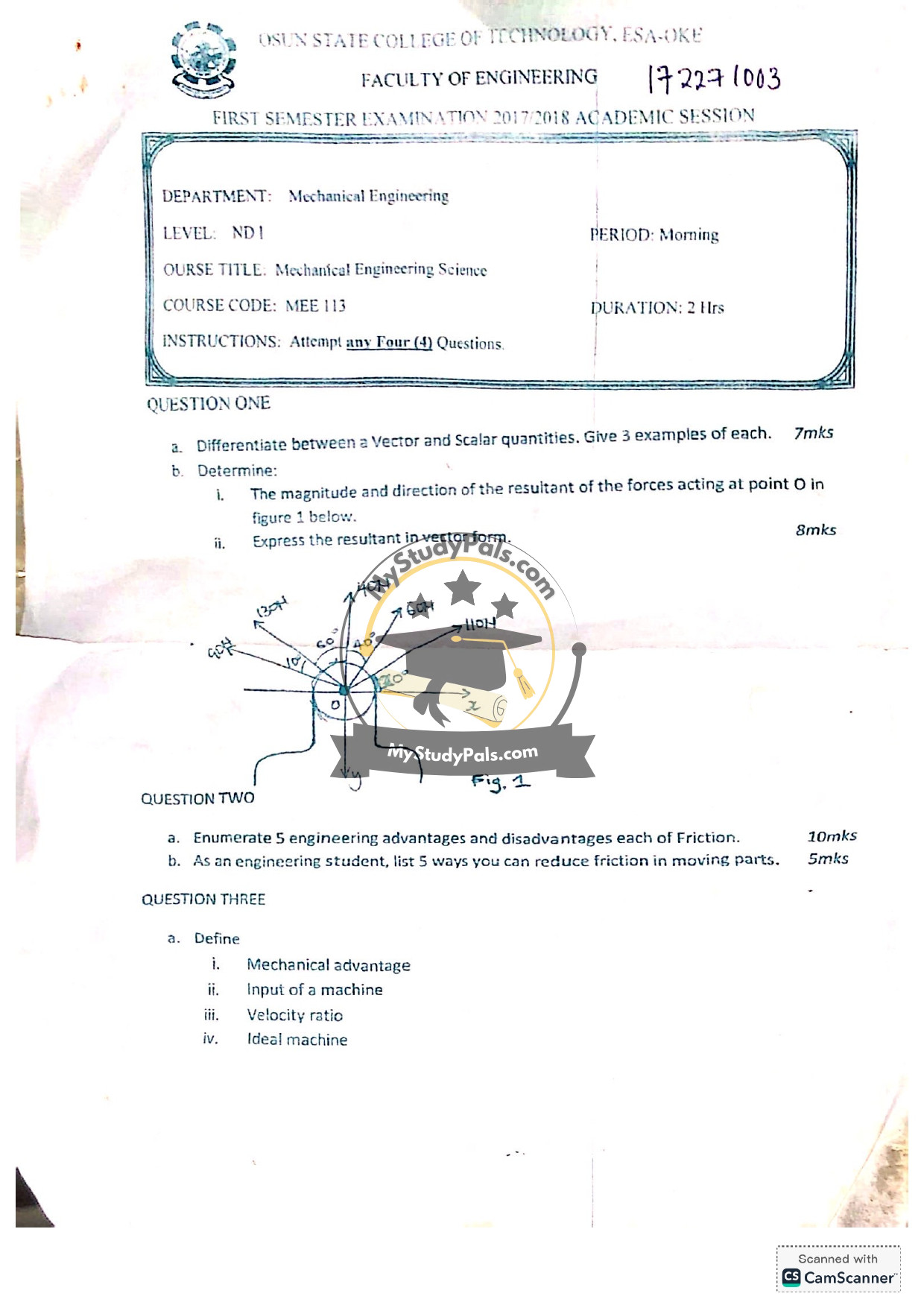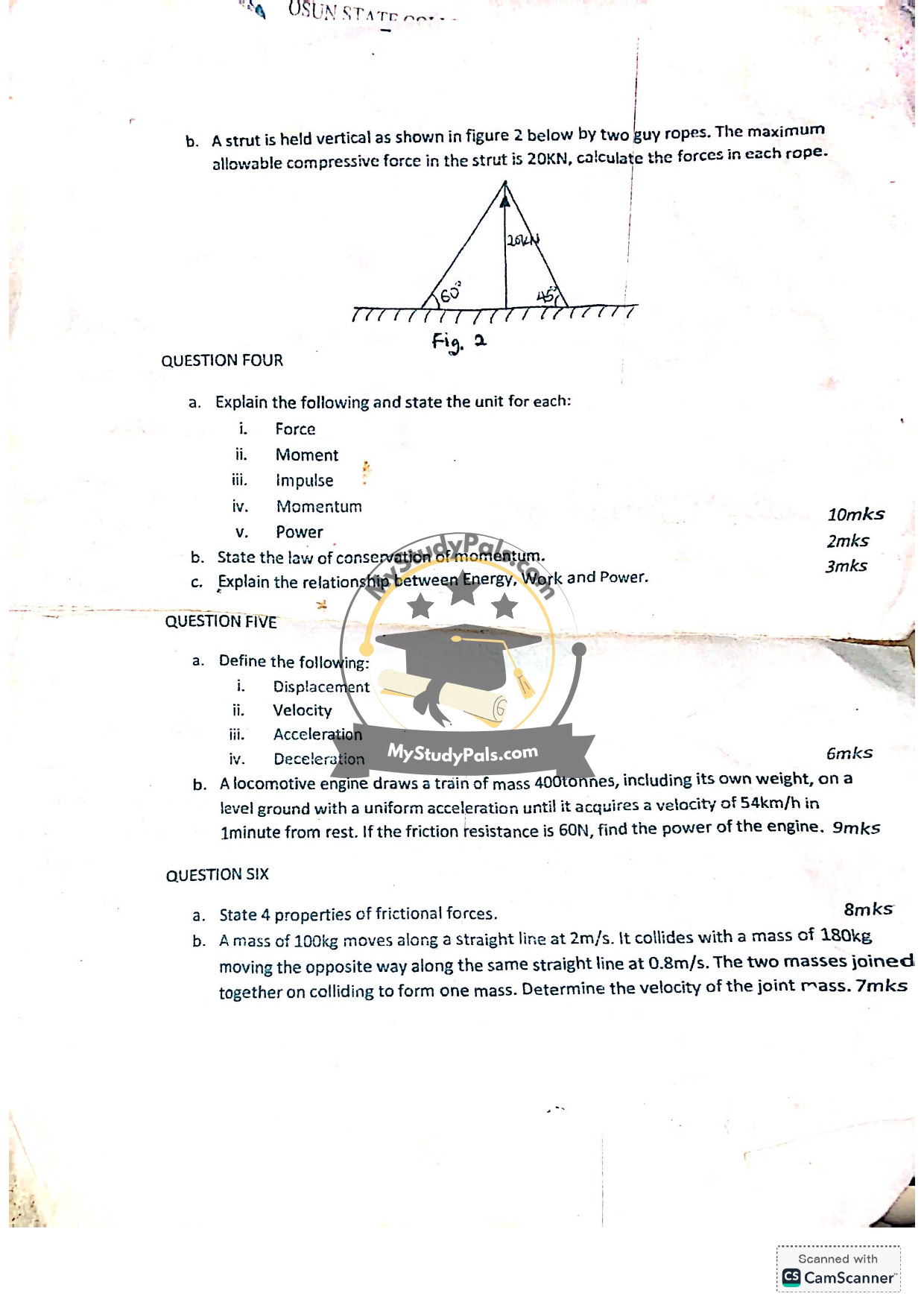ANWSER
Question 1:
a. Vector quantities have both magnitude and direction (e.g., force, velocity, displacement). Scalar quantities have only magnitude (e.g., mass, temperature, time).
b. Without Figure 1, general steps for resultant force:
i. Resolve all forces into horizontal (x) and vertical (y) components.
ii. Sum components: \( \Sigma F_x \), \( \Sigma F_y \).
iii. Magnitude: \( R = \sqrt{(\Sigma F_x)^2 + (\Sigma F_y)^2} \).
iv. Direction: \( \theta = \tan^{-1}(\Sigma F_y / \Sigma F_x) \).
v. Vector form: \( \mathbf{R} = (\Sigma F_x)\mathbf{i} + (\Sigma F_y)\mathbf{j} \).
—
Question 2:
a. Advantages of friction:
– Enables traction for vehicles.
– Allows braking systems.
– Facilitates gripping tools.
– Essential for walking.
– Used in transmission belts.
Disadvantages of friction:
– Causes wear and tear.
– Reduces mechanical efficiency.
– Generates heat.
– Increases energy consumption.
– Produces noise.
b. Reducing friction:
– Lubrication (oil, grease).
– Use ball bearings.
– Smooth/polish surfaces.
– Streamline designs.
– Use low-friction materials (e.g., Teflon).
—
Question 3:
a. Definitions:
i. Mechanical Advantage (MA): Ratio of output force to input force (\( MA = \frac{F_{out}}{F_{in}} \)).
ii. Input of a machine: Work/energy supplied to the machine (unit: Joules).
iii. Velocity Ratio (VR): Ratio of input velocity to output velocity (\( VR = \frac{v_{in}}{v_{out}} \)).
iv. Ideal Machine: Assumes 100% efficiency (no energy loss).
b. Forces in ropes (assumed symmetrical):
– Let \( T_1 \) and \( T_2 \) be tensions.
– Vertical components: \( T_1 \sin\theta + T_2 \sin\theta = 20\ \text{kN} \).
– If angles and rope lengths are equal, \( T_1 = T_2 = \frac{20}{2\sin\theta}\ \text{kN} \).
*(Specific values require Figure 2)*.
—
Question 4:
a. Explanations and units:
i. Force: Push/pull acting on an object (Unit: Newton, N).
ii. Moment: Rotational effect of force (Unit: N·m).
iii. Impulse: Change in momentum (Unit: N·s or kg·m/s).
iv. Momentum: Product of mass and velocity (Unit: kg·m/s).
v. Power: Rate of doing work (Unit: Watt, W).
b. Law of Conservation of Momentum: Total momentum of an isolated system remains constant if no external forces act.
c. Relationship:
– Work is energy transferred by force (\( W = F \cdot d \)).
– Power is work done per unit time (\( P = \frac{W}{t} \)).
– Energy is the capacity to do work.
—
Question 5:
a. Definitions:
i. Displacement: Straight-line distance from start to end (vector).
ii. Velocity: Rate of change of displacement (\( v = \frac{\Delta s}{\Delta t} \)).
iii. Acceleration: Rate of change of velocity (\( a = \frac{\Delta v}{\Delta t} \)).
iv. Deceleration: Negative acceleration (slowing down).
b. Power calculation:
– \( v = 54\ \text{km/h} = 15\ \text{m/s} \), \( t = 60\ \text{s} \).
– Acceleration: \( a = \frac{15}{60} = 0.25\ \text{m/s}^2 \).
– Total force: \( F = ma + \text{friction} = (400,000 \times 0.25) + 60 = 100,060\ \text{N} \).
– Average velocity: \( v_{avg} = \frac{0 + 15}{2} = 7.5\ \text{m/s} \).
– Power: \( P = F \times v_{avg} = 100,060 \times 7.5 = 750,450\ \text{W} \) or 750.45 kW.
—
Question 6:
a. Properties of friction:
– Opposes relative motion.
– Proportional to normal force.
– Independent of contact area.
– Acts parallel to surfaces.
b. Collision velocity:
– Using conservation of momentum:
\( (100 \times 2) + (180 \times -0.8) = (100 + 180)V \).
\( 200 – 144 = 280V \Rightarrow V = \frac{56}{280} = 0.2\ \text{m/s} \).
– Velocity of joint mass: \( 0.2\ \text{m/s} \) (direction of the 100kg mass).



